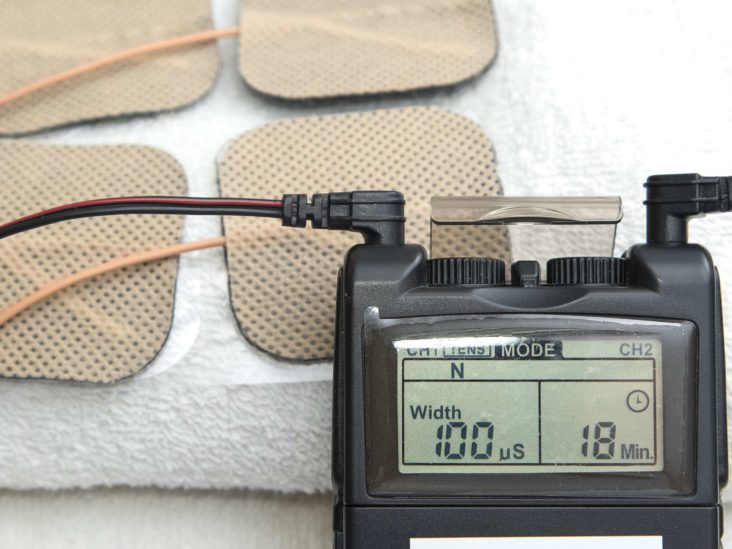As a professional trainer, I've utilized TENS and EMS/PMS devices, and I've decided to write about the distinctions and applications of TENS, EMS, and PMS frequency units.
I'll also try to answer some of the most common questions I get, such as which one to use for knee pain, back pain, and shoulder discomfort.
We all have painful times that we wish would go away in our daily lives. We contemplate taking a pain reliever to help us deal with the discomfort most of the time. However, you may have overlooked the devices that have been increasingly popular in recent years.
TENS and EMS are two well-known machines that you may be familiar with.
You're bound to come across TENS and EMS gadgets if you're looking for a pain-relieving electronic device. People frequently confuse the two for the same reason, even though they each have their own distinct goals to fulfill. It's important to understand that they're built in such a way that they can accomplish a variety of tasks. TENS stands for transcutaneous electrical nerve stimulation, whereas EMS stands for electrical muscle stimulation, often known as PMS – Powered muscular stimulation. When you consider their complete forms, it's clear that they're utilized for a variety of purposes.
Another query regarding them is why they chose these two to relieve pain rather than a painkiller prescription or a narcotic herb. The solution is straightforward and straightforward. It's because TENS or EMS machines can't make you addicted. They create electronic pulses that are both non-painful and non-addictive.
The Difference Between TENS, EMS, and PMS Frequency Units:
As previously said, EMS and PMS devices are essentially the same, so let's focus on them instead of TENS.
The distinction between these two is that they have different capacities. TENS stands for transcutaneous electrical nerve stimulation, and it is used to treat muscle discomfort. On the other hand, EMS has the perseverance to assist your muscles in growing and training for sporting goals.
Even though they both perform therapeutic activities, they operate in very distinct ways.
TENS is the way to go if you're suffering from severe muscle pain and want to get your hands on a pain-relieving device.
EMS devices are designed to help you recover from an accident, train your muscles for sporting goals, and avoid relying simply on pain treatment.
Another significant distinction between the two is that TENS devices are used to stimulate nerves. In contrast, EMS is used to relax and strengthen muscles. As a result, mixing them up will be a mistake.
Functionality:

TENS (Transcutaneous Electrical Nerve Stimulation) Devices:
TENS, or transcutaneous electrical nerve stimulation, is supposed to function by interrupting pain signals with electric pulses to bring relief and comfort to the affected area. These electrical pulses are painless and function only to relax and soothe the area where you are experiencing discomfort. These stimulations are delivered through the skin and effectively reduce pain in the affected area. It works anyplace on your body to relieve pain so that you may use it anywhere.
What Are TENS Units and How Do They Work?
Basically, this device is a pain reliever. It works by employing electrical stimulators to disrupt and divert pain-causing signals, resulting in a relaxing effect. It is known to confuse pain signals and divert them in order to relieve pain. It can also encourage your body to manufacture its natural painkillers. These pain relievers and beneficial substances can also improve and lighten your mood. You can change the TENS device's mode to whatever you like. For example, you can set it to the maximum if you have excruciating back pain. The intensity and duration of pain may vary, and you can choose and change the modes accordingly.
Devices for EMS/PMS:
Electrical Muscle Stimulator (EMS) and Powered Muscle Stimulator (PMS) devices focus on muscle movement and contract the muscles to give a healthy movement using electronic pulses or charge. It also has a healing effect on your muscles. An Electric Muscle Stimulation device can also help you recover from an accident by rehabilitating your muscles. Furthermore, it is capable of performing athletic training for you.
What Are the Functions of EMS/PMS Units?
The EMS device distributes electrical charges to the muscle fibers after placing the terminals over the skin of the afflicted muscles, forcing the muscle to contract. This contraction is the same as the one you get when you exercise or move about.
TENS machines are not the same as providing motion signals to force muscles to contract. EMS devices can help with muscle exhaustion, edema, discomfort, and tension. It ensures that your muscles are in good shape. An EMS device can also be used to provide muscular pain relief. It can also be used in a home environment to promote healing by increasing blood flow.
When TENS and EMS Devices Should Be Used?

TENS Machines:
The main objective of a TENS device is to relieve pain in the body. You can use it if you have chronic pain, pain after a surgical procedure, migraines, an injury that produces discomfort, if you have cancer pain, pregnancy pain, or even if you have a healed wound. Because of their unique application, TENS machines can be employed at a variety of locations.
EMS Devices:
Unlike TENS machines, EMS can be used to treat muscular discomfort. If you have poor blood circulation, muscle tiredness, weak muscles, muscles that require stimulation, muscular injury, inability to move muscles due to injury, or if you have recently undergone surgery, EMS devices will assist you in resolving these issues altogether. When you have an experience similar to the ones above, using an EMS device can help you relax and relieve the discomfort. You can also use it to boost your yield during a workout.
EMS devices are now found in many gyms. They have become popular training tools for anyone looking to strengthen their muscles. You can use EMS devices in conjunction with weights or a treadmill to enhance the effort level or only use EMS.
TENS vs. EMS for Back Pain: Which Is Better?
It is critical to select the appropriate gadget for the task at hand. Because we've gone over the distinctions between these two devices in detail, picking the appropriate one for the proper job is no longer difficult. You might get a searing discomfort in your back now and then. To get rid of it, you'll need to figure out whether the discomfort is due to muscular tiredness or if it's due to something else. Stiffness will confirm that the discomfort is coming from the muscles.
If you're suffering from muscle exhaustion, an EMS device can help you relax and calm your back muscles. It will also help to normalize blood flow in your back muscles. Suppose the primary goal is to relieve pain. In that case, there are no muscular abnormalities involved, and nerves cause it; a TENS device should be utilized. TENS devices are commonly used to treat back pain.
Knee Pain: TENS vs. EMS:
Knees are the joints that are flexed numerous times during the day. Knee discomfort is caused by the high pace of movement and the high risk of damage. Knee pain can mean a variety of things. It could be due to a muscular imbalance or a strain on the knee nerves.
Check it out right now to see if you need a TENS machine or an EMS machine to treat your discomfort.
TENS vs. EMS for Shoulder Pain:
Shoulder pain can be terrible, and it can also create inflammatory feelings. To decide which of the two the best option for shoulder discomfort is, you must first determine what type of pain you are suffering. You might get advice from a doctor or a therapist for this. If nerves cause pain, consider utilizing a TENS unit to relieve it. If it's due to muscle spasms and poor blood circulation, and EMS machine is the way to go.
A device that combines TENS and EMS:
A combo gadget that includes both EMS and TENS is also an option. It is a bit pricey, but it is versatile because it combines the features of both machines. TENS will alleviate their everyday pain, while EMS will build and train their muscles. It can help with back pain, neck discomfort, and shoulder pain and strengthen the muscles in those regions to prevent future suffering. It is the ideal equipment for an athlete or a sportsman. Because it is portable, you may carry it with you everywhere you go. It also represents a good value because you only need to purchase one gadget rather than two.
Furthermore, your blood flow will be adjusted, which will relieve you of the pain. As a result, whether it's muscular pain or chronic nerve pain, you'll be able to get rid of both at the same time.
I hope this article has clarified the distinctions between TENS, EMS, and PMS frequency units.
Katheryn is a corporate attorney and finance specialist, conducting research daily to get you closer to financial security and freedom (even if you're just getting started). Her +600 articles published in Collaborative Research Group have already helped thousands of readers on the internet. .
Leave a reply
Your email address will not be published. Required fields are marked *Recent post

How to Watch Instagram Stories without them Knowing: 6 Ways to do it



